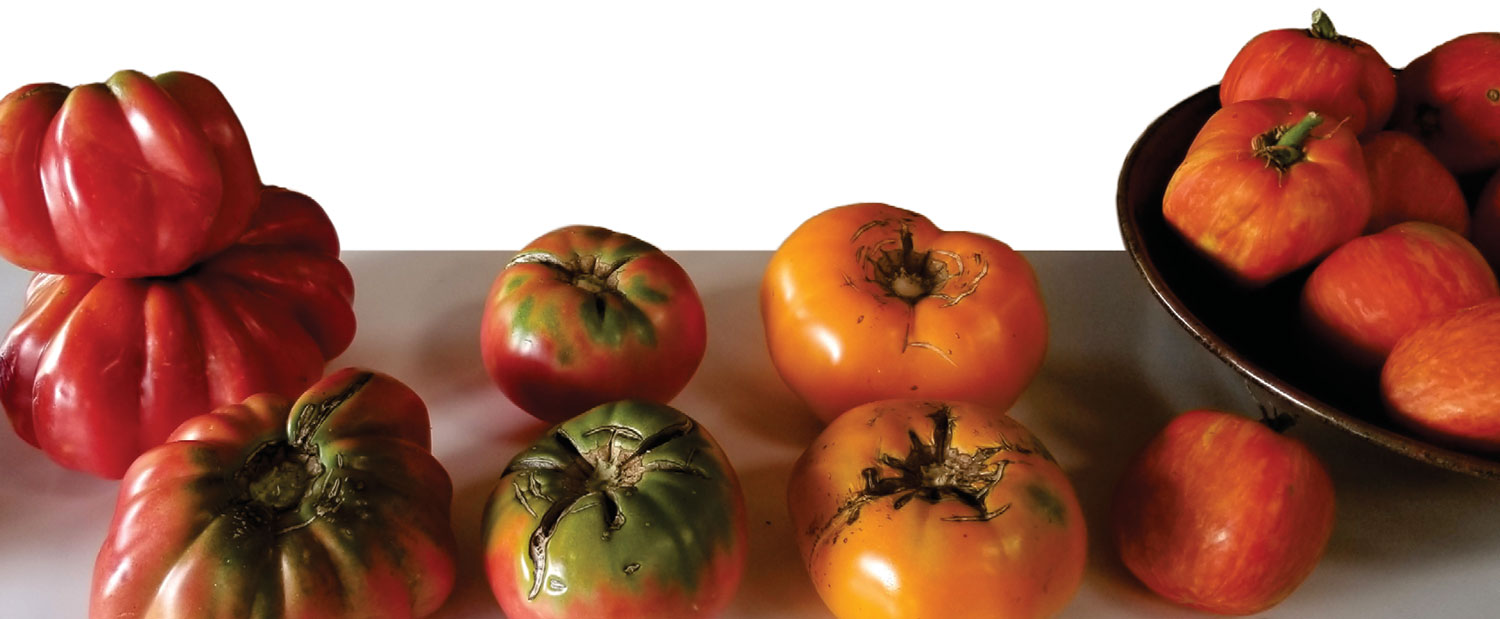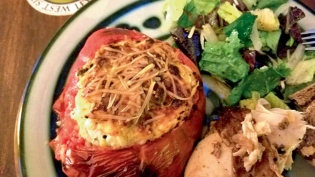In The Garden: Tomato Triple Crown
I have grown dozens of heirloom tomato varieties over the years. I have records dating back to 2008 that note plant performance, yield, taste and perishability. I don’t remember growing many heirlooms before I moved back out to the farm in 2003. It probably wasn’t until about then that these old, open-pollinated, full-flavored varieties started to become available again.
Today, heirloom varieties seem to be the preferred garden tomato. We used to be told that the newer hybrids were better because of disease resistance and uniformity in form and function. No, thanks! I want diversity, imperfections and above all a range of unique tastes that only come from a tomato that has been painstakingly preserved over the years by the gardener who saves seed, shares seed. These seeds tell stories not just about a fruiting vine but about the people who might have carried them in their pocket as they made their way to a new country a lifetime ago.
I no longer believe the rhetoric that heirloom tomato varieties are more difficult to grow, are disease prone and lack shelf life. Instead, it may very well be old-school conventional gardening practices that perpetuated those myths. I am convinced that my organic practices have given my plants a healthy foundation from which to grow and flourish. My soil has been feed with composted manure, it drains well, the plants are immediately mulched with grass clippings after planting and the only fertilizer that has been used is fish emulsion. The manure feeds them slowly and the fish emulsion gives them a little extra nitrogen (5-1-1) from time to time.
I planted 16 different heirloom varieties this summer season and there are five hands-down favorites. The cool thing about these favorites is that each one of them came from my neighbor, Todd Bitzer. In fact, one of the tomatoes is actually named after Todd. (See what I mean about the gardener who saves seed, shares seed and tells the story of the seed? It gets you a tomato namesake!)
This year was a challenging year because of lots of rain and periods of high heat. Despite that, ‘Furry Boar,’ ‘Todd Bitzer,’ ‘Big Elmer,’ ‘Rosa’ and ‘Goat Bag’ did fantastic. The plants remained disease-free and full of green foliage and ripening fruit well into late summer. All my other plants (heirlooms, too) looked pathetic. Before I tell you about the failures, let me tell you about the successes.
‘Red Furry Boar’ was the first to come on strong in early July, and it never stopped. Bradley Gates grows exotic tomatoes at Wild Boar farms outside of Napa, California. Anytime you see boar associated with a tomato’s name, snatch it up because it has it provenance from Wild Boar Farms. Most of the Wild Boar tomatoes are bi-colored and striped. ‘Red Furry Boar’ has a matte skin that makes it unusual beyond its streaked pale red and yellow fruit. The flesh is firm and flavorful and seems to be the least interesting to tomato-eating pests. This may be the most unusual tomato I have ever grown … oh, but wait a minute: ‘Goat Bag.’
Yes, ‘Goat Bag’ does, in fact, look like just that. This tomato is extra-large, a prolific producer, and it taste great, sort of on the grassy side. ‘Goat Bag’ is what we call a potato-leaf variety because the foliage of the plant looks like potato leaves. I have heard many old-timers talk about the vigor of potato-leaf varieties and I am beginning to believe the lore.
‘Rosa’ is a true stuffing tomato. She is not ideal for slicing or tossing in a Greek salad but you can easily core out the tomato without it falling apart and stuff it with just about anything. The unusual large, fluted fruit gives it some balance on the baking sheet, not unlike the buttresses that help to hold up Notre Dame cathedral. No joke. A stuffed tomato never looked so beautiful on the plate.
‘Big Elmer’ and ‘Todd Bitzer’ round out the favorites in traditional style. These two are just the perfect yellow and red slicing tomato. Prolific producers, good shelf life on my counter and the perfect summer tomato taste. Two more potato-leaf varieties that showed no sign of stress or disease. The only problem was the young squirrel that was born in our barn this spring. The little guy thought the vegetable garden was his own. I just planted enough for everyone.
The consolation prize goes to ‘Japanese Black Trifele’ (potato- leaf) and ‘Chocolate Sprinkles.’ Both are “chocolatey-red” in color. ‘Japanese Black Trifele’ has medium pear-shape fruit and ‘Chocolate Sprinkles’ is a pear-shaped cherry tomato. This is where I must confess my failure of the season. A lapse in memory regarding companion planting doomed a quarter of my tomato plantings. I had forgotten that it is best not to plant nightshades next to other nightshades. Guess what I did: I planted a row of tomatoes right next to a row of potatoes. Guess what else: The potato yield was puny, too. These two chocolatey tomatoes were planted next to the horseradish so they did not suffer from my poor planning.
So, here are the lessons from a wet and hot 2018 tomato growing season: Stack the deck by planting heirloom potato-leaf varieties (and do not plant them right next to actual potatoes) and believe in good taste above all else. Plant more then you need because I am certain the squirrels know they have a good thing going in the loft of our barn. And, remember: No matter what happens, there is always next year.
Preparing for success
• Prepare a bed rich in organic matter; this will insure that it is well-drained.
• Wait to plant until the soil and ambient air temperature are warm.
• Mulch plants immediately after planting to avoid spreading soil-borne diseases.
• Rotate crops annually. Avoid mixing plants in the nightshade family like tomatoes, eggplant and potatoes.







